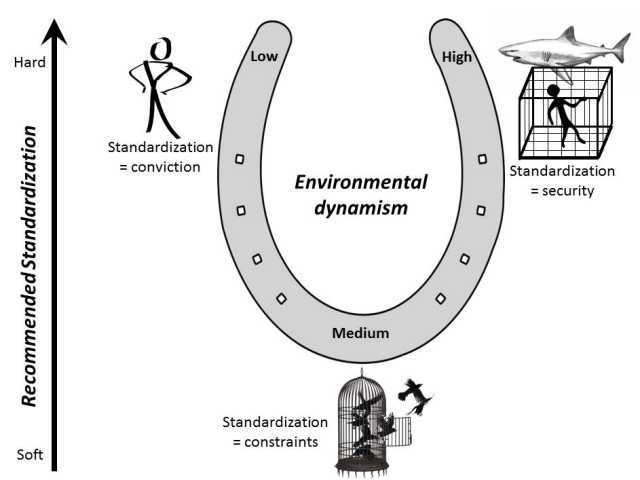Blog: Strategy: Finding a good fit
| Datum: | 23 november 2017 |

Vinci-researcher Charles Carroll
Strategic management often focuses on finding a fit between the firm and its environment. This could involve changing the firm, the environment, or both in order to create a good fit. This process of creating a good fit can get very complex with a bewildering set of trade-offs. The trick for strategists is to make sense of that complexity and boil it down to a simple, compelling vision that the rest of the firm can rally around.
I worked with our Vinci experts in franchising, Evelien Croonen and Maryse Brand, to understand how the growth of franchises is affected by that fit. Evelien, Maryse, and colleagues have compiled data on 53 Dutch franchises over 8 years. Together, we examined how the degree of standardization of the franchises interacts with the level of dynamism in the industry to affect the growth rate of those franchises. The franchises were fairly evenly distributed across these conditions: standardization (hard=60%, soft=40%), dynamism (low=36%, medium=36%, high=28%).
Which is better: hard or soft franchising?
Franchises grow by attracting franchisees who want to open a new outlet of their own. So, what conditions attract new franchisees? On one hand, a standardized business format (hard franchising) improves efficiency and economies of scale and it presents a uniform brand image to customers. On the other hand, giving outlets more flexibility (soft franchising) allows franchisees to act entrepreneurially in adapting to changing trends or local variations in consumer preferences. This autonomy also gets franchisees more engaged and improves their personal satisfaction. So, there are sound arguments supporting both hard and soft approaches, but how do they fit in the environment? Specifically, which works better in stable versus dynamic environments?
In stable industries (such as alcohol, tobacco, bookstores, Do-It-Yourself stores, and building materials), there is little reason to experiment with a proven formula. Standardization reflects the conviction that the formula works, and it does not need to be tweaked by franchisees. Centralized sourcing through the franchisor also capitalizes on economies of scale. Indeed, we found that franchises using hard formulas in stable industries added retail units while those using soft formulas lost units.
In moderately dynamic industries (such as fast food, restaurants, fruits and vegetables, audio-visual equipment, electronics, and furniture) there are more opportunities to establish new units, but the risk of failure is also higher. Given the uncertainty about what works best, franchisees are more likely to join soft franchising systems that give them more maneuvering room when managing their substantial investment. Consequently, the soft franchises grew faster on average than the hard franchises in moderately dynamic environments. However, a word of caution is needed here: some of the soft franchises expanded rapidly while others contracted nearly as fast. On one hand, entrepreneurial experimentation creates opportunities to adapt, and the whole franchise can learn from discoveries made by individual franchisees. Ideally, a soft franchise could establish a culture for learning that attracts the best and the brightest franchisees. However, if the flexibility merely reflects a muddled vision, then those soft franchises lost units at an alarming rate. So, in a moderately dynamic environment, the soft systems grew faster, but care should be taken that all of the franchisees have adopted the same vision.
In highly dynamic industries (such as fashion and clothing, perfumes and cosmetics, chocolates and confectioneries, dairy, and processed foods), the rate of entry and exit of retail units is extremely high. The intense dynamism increases the risk that potential franchisees could lose their entire investment. Consequently, franchisees become less willing to trust their own entrepreneurial instincts and more willing to accept the wisdom and experience of the established franchisor. Standardization also helps to attract customers by establishing a consistent brand image; this allows customers to reduce their own uncertainty when choosing among competing products. While this high degree of standardization rules out the bottom-up learning process associated with a soft system, franchisors can quickly enact top-down changes throughout the entire system because all of the franchisees have agreed to conform to the given formula. As we expected, in extremely dynamic environments, hard franchises tended to add retail units, while soft franchises tended to lose them.
Figure. Recommended level of standardization given the level of environmental dynamism
The big picture
Standardization can be thought of as an iron cage (see the figure above). In a stable environment, it is easy to tell if a franchise formula works; standardization reinforces that formula with an ironclad conviction that adjustments are neither needed nor wanted. In contrast, in a moderately dynamic environment, the viability of a formula is less certain; standardization feels more like a bird cage that prevents entrepreneurs from spreading their wings. However, at very high levels of dynamism, the risk of catastrophic failure is much higher. In this scary context, standardization feels more like a shark cage protecting the vulnerable franchisee from the threatening environment. The overall pattern that emerges resembles a horseshoe in that the extreme levels of dynamism are closer to each other than they are to a moderate level of dynamism. Under both extremes of dynamism, hard franchise systems provide the best fit and the fastest growth. However, the opposite is true under moderate dynamism; soft franchising fits the best and yields the fastest growth.
If you are searching for a good fit and you find yourself confronted with a tangled web of trade-offs, we would be happy to help you sort them out and find your own clear vision forward.
Want to know more? Don’t hesitate to contact the author of this post: Charlie Carroll, c.carroll@rug.nl
